"I like to believe that people in the long run are going to do more to promote peace than our governments. Indeed, I think that people want peace so much that one of these days governments had better get out of the way and let them have it." - Dwight D. Eisenhower
Dwight David (Ike) Eisenhower [1890-1969] was the 34th President of the United States from 1953 until 1961. Prior to that, he was a five-star general in the US Army. During World War II, he served as Supreme Commander of the Allied Forces in Europe; he had responsibility for planning & supervising the invasion of North Africa in Operation Torch in 1942–43 & the successful invasion of France & Germany in 1944–45, from the Western Front. After World War II, Eisenhower served as Chief of Staff under President Harry S. Truman, then assumed the post of President at Columbia University. In 1951, he became the first supreme commander of the North Atlantic Treaty Organization (NATO).
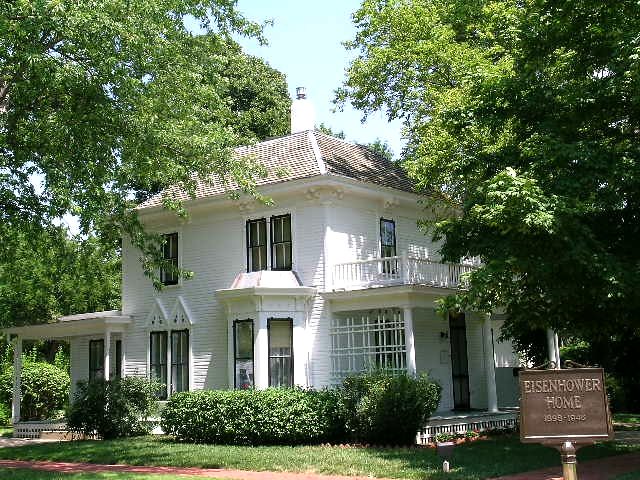 | 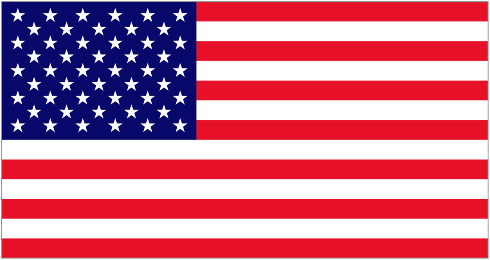  October 14, 1890 - Birth of Dwight D. Eisenhower, Denison, Texas (USA). Third of seven boys. In 1892, the family moved to Abilene, Kansas, which Eisenhower considered as his home town. Though his mother was against war, it was her collection of history books that first sparked Eisenhower's early & lasting interest in military history. He persisted in reading the books in her collection and became a voracious reader in the subject. Eisenhower attended Abilene High School & graduated with the class of 1909. His decision to attend the US Military Academy (West Point) saddened his mother, who felt that warfare was 'rather wicked,' but she did not overrule him. Image shows Eisenhower home on grounds of the Eisenhower Presidential Library & Museum in Abilene. October 14, 1890 - Birth of Dwight D. Eisenhower, Denison, Texas (USA). Third of seven boys. In 1892, the family moved to Abilene, Kansas, which Eisenhower considered as his home town. Though his mother was against war, it was her collection of history books that first sparked Eisenhower's early & lasting interest in military history. He persisted in reading the books in her collection and became a voracious reader in the subject. Eisenhower attended Abilene High School & graduated with the class of 1909. His decision to attend the US Military Academy (West Point) saddened his mother, who felt that warfare was 'rather wicked,' but she did not overrule him. Image shows Eisenhower home on grounds of the Eisenhower Presidential Library & Museum in Abilene.
|
 |   1942-1955 - President's Globe, Washington, DC (USA). "The US Office of Strategic Services (OSS) Map Division compiled the map for a 50-inch globe that was to be given to President Roosevelt by Colonel William J. Donovan, the OSS Director. Instead, acting on a suggestion by General Dwight D. Eisenhower, General George C. Marshall arranged to have one of the large globes presented to Prime Minister Winston Churchill & another to President Roosevelt as 1942 Christmas gifts from the US Army. Ultimately, the Weber Costello Company of Chicago Heights, Illinois, produced some twelve or fifteen copies of the President's Globe between 1942 & 1955 when the company ceased operation. Churchill's globe is now at Chartwell, & Roosevelt's is at the Franklin D. Roosevelt Library. The story of these globes is based on the recollection of the author, who was involved in the map making." Diameter = 50 inches. One is now in Library of Congress? 1942-1955 - President's Globe, Washington, DC (USA). "The US Office of Strategic Services (OSS) Map Division compiled the map for a 50-inch globe that was to be given to President Roosevelt by Colonel William J. Donovan, the OSS Director. Instead, acting on a suggestion by General Dwight D. Eisenhower, General George C. Marshall arranged to have one of the large globes presented to Prime Minister Winston Churchill & another to President Roosevelt as 1942 Christmas gifts from the US Army. Ultimately, the Weber Costello Company of Chicago Heights, Illinois, produced some twelve or fifteen copies of the President's Globe between 1942 & 1955 when the company ceased operation. Churchill's globe is now at Chartwell, & Roosevelt's is at the Franklin D. Roosevelt Library. The story of these globes is based on the recollection of the author, who was involved in the map making." Diameter = 50 inches. One is now in Library of Congress?
|
April 1948 - Marshall Plan.

 April 16, 1953 - "The Chance for Peace," Washington, DC (USA). Speech by Dwight D. Eisenhower.
April 16, 1953 - "The Chance for Peace," Washington, DC (USA). Speech by Dwight D. Eisenhower.

 December 8, 1953 - "Atoms for Peace," United Nations, New York City, New York (USA). Speech by Dwight D. Eisenhower. "In August 1954, Congress approved Eisenhower's proposals, & the way was open for positive international
co-operation."
December 8, 1953 - "Atoms for Peace," United Nations, New York City, New York (USA). Speech by Dwight D. Eisenhower. "In August 1954, Congress approved Eisenhower's proposals, & the way was open for positive international
co-operation." 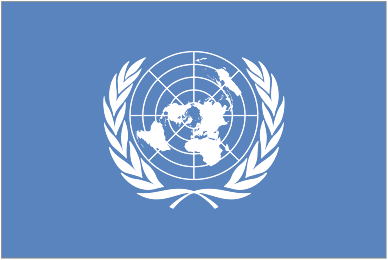
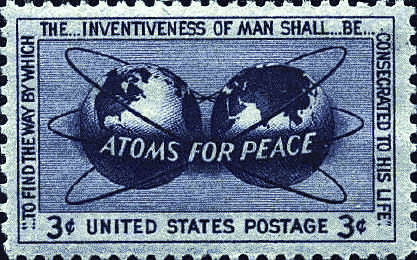
|  1955 - Postage stamp commemorating the US Government's "Atoms for Peace" program (intended to share nuclear technology while limiting the production of nuclear weapons.). Edges of the stamp read "...to find the way by which the...inventiveness of man shall...be...consecrated to his life." A quotation from President Eisenhower's "Atoms for Peace" speech to the United Nations? 1955 - Postage stamp commemorating the US Government's "Atoms for Peace" program (intended to share nuclear technology while limiting the production of nuclear weapons.). Edges of the stamp read "...to find the way by which the...inventiveness of man shall...be...consecrated to his life." A quotation from President Eisenhower's "Atoms for Peace" speech to the United Nations? 
|
 

|  August 1955 - First International Conference on the Peaceful Uses of Atomic Energy, Geneva (Switzerland). Often called the Atoms for Peace conference. Left image shows Atoms For Peace symbol used by the US Atomic Energy Commission (AEC). It was was mounted over the door to the American swimming pool reactor building during the 1955 conference. Around a representation of an atom are symbolised four areas civil atomic energy: scientific research, medicine, industry & agriculture. Two olive branches symbolise peaceful use. Right image shows physicist Tom Cole who conceived the reactor and then helped construct it at Oak Ridge National Laboratory (ORNL). Additional conferences were held in 1958, 1964 & 1971. August 1955 - First International Conference on the Peaceful Uses of Atomic Energy, Geneva (Switzerland). Often called the Atoms for Peace conference. Left image shows Atoms For Peace symbol used by the US Atomic Energy Commission (AEC). It was was mounted over the door to the American swimming pool reactor building during the 1955 conference. Around a representation of an atom are symbolised four areas civil atomic energy: scientific research, medicine, industry & agriculture. Two olive branches symbolise peaceful use. Right image shows physicist Tom Cole who conceived the reactor and then helped construct it at Oak Ridge National Laboratory (ORNL). Additional conferences were held in 1958, 1964 & 1971. 
|

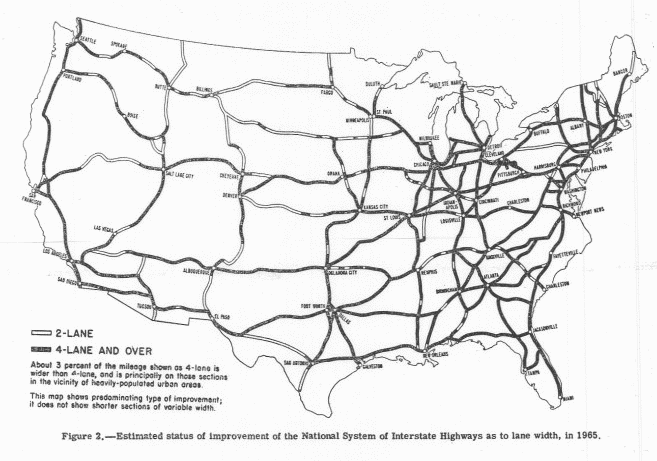

|  1956 - Dwight D. Eisenhower National System of Interstate & Defense Highways (commonly known as the Interstate Highway System, Interstate Freeway System or simply "the Interstate") is a network of limited-access roads including freeways, highways, & expressways forming part of the US National Highway System. Named for President Dwight D. Eisenhower, who championed its formation. Connects 209 of the 237 cities having a populaiton of 50,000 or more. Construction was authorized by the Federal Aid Highway Act of 1956, & the original portion was completed 35 years later. The network has since been extended &, as of 2006, had a total length of 46,876 miles (75,440 km). About one-third of all miles driven in the USA use the Interstate system (2003 figures). The cost of construction has been estimated at $425 billion (in 2006 dollars), making it the largest public works project in history. Map shows the system as of 1965. Standard system sign showing Eisenhower's five-star insignia was introduced in 1993. 1956 - Dwight D. Eisenhower National System of Interstate & Defense Highways (commonly known as the Interstate Highway System, Interstate Freeway System or simply "the Interstate") is a network of limited-access roads including freeways, highways, & expressways forming part of the US National Highway System. Named for President Dwight D. Eisenhower, who championed its formation. Connects 209 of the 237 cities having a populaiton of 50,000 or more. Construction was authorized by the Federal Aid Highway Act of 1956, & the original portion was completed 35 years later. The network has since been extended &, as of 2006, had a total length of 46,876 miles (75,440 km). About one-third of all miles driven in the USA use the Interstate system (2003 figures). The cost of construction has been estimated at $425 billion (in 2006 dollars), making it the largest public works project in history. Map shows the system as of 1965. Standard system sign showing Eisenhower's five-star insignia was introduced in 1993.
|
 |   March 28, 1969 - Death of Dwight D. Eisenhower, Walter Reed Army Hospital, Washington, DC (USA). The following day his body was moved to the Washington National Cathedral's Bethlehem Chapel, where he lay in repose for 28 hours. On March 30, his body was brought by caisson to the US Capitol, where he lay in state in the Capitol Rotunda. On March 31, Eisenhower's body was returned to the National Cathedral, where he was given an Episcopal Church funeral service. That evening, Eisenhower's body was placed onto a train en route to Abilene, Kansas. His body arrived on April 2, and was interred later that day in a small chapel on the grounds of the Eisenhower Presidential Library. Image shows his and Mamie's graves on grounds of the Eisenhower Presidential Library & Museum in Abilene in 1997. March 28, 1969 - Death of Dwight D. Eisenhower, Walter Reed Army Hospital, Washington, DC (USA). The following day his body was moved to the Washington National Cathedral's Bethlehem Chapel, where he lay in repose for 28 hours. On March 30, his body was brought by caisson to the US Capitol, where he lay in state in the Capitol Rotunda. On March 31, Eisenhower's body was returned to the National Cathedral, where he was given an Episcopal Church funeral service. That evening, Eisenhower's body was placed onto a train en route to Abilene, Kansas. His body arrived on April 2, and was interred later that day in a small chapel on the grounds of the Eisenhower Presidential Library. Image shows his and Mamie's graves on grounds of the Eisenhower Presidential Library & Museum in Abilene in 1997.
|

 |   January 15, 1991 - Peace Monument, Harrison County Courthouse, Corydon, Indiana (USA). Inscription: "Dedicated to the Peaceful Resolution of Conflict. Every gun that is made, every warship launched, every rocket fired signifies, in the final sense, a theft from those who hunger and are not fed, those who are cold and are not clothed. This world in arms is not spending money alone, it is spending the sweat of its laborers, the genius of its scientists, the hopes of its children. -- Dwight D. Eisenhower." Dedicated on MLK, Jr.'s birthday. January 15, 1991 - Peace Monument, Harrison County Courthouse, Corydon, Indiana (USA). Inscription: "Dedicated to the Peaceful Resolution of Conflict. Every gun that is made, every warship launched, every rocket fired signifies, in the final sense, a theft from those who hunger and are not fed, those who are cold and are not clothed. This world in arms is not spending money alone, it is spending the sweat of its laborers, the genius of its scientists, the hopes of its children. -- Dwight D. Eisenhower." Dedicated on MLK, Jr.'s birthday.
|
 |

 December 4, 2004 - World War II Illinois Veterans Memorial, Oak Ridge Cemetery, 1441 Monument Avenue, Springfield, Illinois (USA). "Designed by Jess Poss, who collaborated with Isaksen-Glerum Architects. The centerpiece of the granite & concrete structure is a 12 foot diameter globe sculpted by Dann Nardi & signifies the global proportions of WW-II" There are stainless steel buttons embedded in this globe which identify strategic/major battles in the European & Pacific Theaters of the war. Then there are black granite walls that cascade out from the white globe with a wonderful TIME LINE of this war. One of my favorite quotes engraved on the black granite is: 'THE EYES OF THE WORLD ARE UPON YOU. THE HOPES AND PRAYERS OF LIBERTY LOVING PEOPLE EVERYWHERE MARCH WITH YOU' General Dwight D. Eisenhower." December 4, 2004 - World War II Illinois Veterans Memorial, Oak Ridge Cemetery, 1441 Monument Avenue, Springfield, Illinois (USA). "Designed by Jess Poss, who collaborated with Isaksen-Glerum Architects. The centerpiece of the granite & concrete structure is a 12 foot diameter globe sculpted by Dann Nardi & signifies the global proportions of WW-II" There are stainless steel buttons embedded in this globe which identify strategic/major battles in the European & Pacific Theaters of the war. Then there are black granite walls that cascade out from the white globe with a wonderful TIME LINE of this war. One of my favorite quotes engraved on the black granite is: 'THE EYES OF THE WORLD ARE UPON YOU. THE HOPES AND PRAYERS OF LIBERTY LOVING PEOPLE EVERYWHERE MARCH WITH YOU' General Dwight D. Eisenhower."
|



![]() April 16, 1953 - "The Chance for Peace," Washington, DC (USA). Speech by Dwight D. Eisenhower.
April 16, 1953 - "The Chance for Peace," Washington, DC (USA). Speech by Dwight D. Eisenhower.
![]() December 8, 1953 - "Atoms for Peace," United Nations, New York City, New York (USA). Speech by Dwight D. Eisenhower. "In August 1954, Congress approved Eisenhower's proposals, & the way was open for positive international
co-operation."
December 8, 1953 - "Atoms for Peace," United Nations, New York City, New York (USA). Speech by Dwight D. Eisenhower. "In August 1954, Congress approved Eisenhower's proposals, & the way was open for positive international
co-operation."







